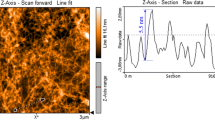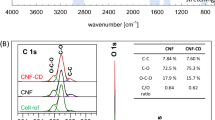Abstract
This paper reports on the use of cellulose nanofibrils (CNFs) and (3-mercaptopropyl) trimethoxysilane (MPTMS) to prepare compressible aerogels. The aerogels were functionalized with diallydimethylammonium chloride (DADMAC) and N,N’-methylenebis(acrylamide) (MBAA) via the thiol-ene click reaction to remove anionic dye methyl orange (MO) from wastewater. The controlled hydrolysis and condensation of MPTMS on CNF produced a hydrogel that was freeze dried to form a compressible aerogel. The aerogel was modified by polymerizing DADMAC on the surface to impart functional groups for dye binding, and this was further enhanced through the addition of MBAA at varying initial ratios to enhance DADMAC incorporation. The aerogel displayed a maximum adsorption capacity 186.7 mg/g determined from the Langmuir model for MO dye. Kinetic experiments revealed that the mass transfer rate of MO dye into the aerogel was described by the pore diffusion model, having a pore diffusion coefficient of 1.8 × 10–9 m2/s. The effect of environmental conditions, such as solution pH, ionic strength and temperature demonstrated that the adsorption was influenced by electrostatic interactions between the MO and adsorbent surface, followed by physisorption. After regeneration of the aerogel using 2 M NaCl, the adsorbent retained 77% of its initial adsorption capacity.








Similar content being viewed by others
References
Sharma P, Kaur H, Sharma M, Sahore V (2011) A review on applicability of naturally available adsorbents for the removal of hazardous dyes from aqueous waste. Environ Monit Assess 183:151–195. https://doi.org/10.1007/s10661-011-1914-0
You S, Cheng S, Yan H (2009) The impact of textile industry on China’s environment. Int J Fash Des Technol Educ 2:33–43. https://doi.org/10.1080/17543260903055141
Chavan R (2001) Indian textile industry-environmental issues. Indian J Fibre Text Res 26:11–21
Mittal A, Malviya A, Kaur D et al (2007) Studies on the adsorption kinetics and isotherms for the removal and recovery of Methyl Orange from wastewaters using waste materials. J Hazard Mater 148:229–240. https://doi.org/10.1016/j.jhazmat.2007.02.028
Ma H, Burger C, Hsiao BS, Chu B (2012) Nanofibrous microfiltration membrane based on cellulose nanowhiskers. Biomacromol 13:180–186. https://doi.org/10.1021/bm201421g
Quinlan PJ, Tanvir A, Tam KC (2015) Application of the central composite design to study the flocculation of an anionic azo dye using quaternized cellulose nanofibrils. Carbohydr Polym 133:80–89. https://doi.org/10.1016/j.carbpol.2015.06.095
Huang Y, Li H, Balogun MS et al (2014) Oxygen vacancy induced bismuth oxyiodide with remarkably increased visible-light absorption and superior photocatalytic performance. ACS Appl Mater Interfaces 6:22920–22927. https://doi.org/10.1021/am507641k
Mohammed N, Grishkewich N, Waeijen HA et al (2016) Continuous flow adsorption of methylene blue by cellulose nanocrystal-alginate hydrogel beads in fixed bed columns. Carbohydr Polym 136:1194–1202. https://doi.org/10.1016/j.carbpol.2015.09.099
Kannan N, Sundaram MM (2001) Kinetics and mechanism of removal of methylene blue by adsorption on various carbons—a comparative study. Dye Pigment 51:25–40. https://doi.org/10.1016/S0143-7208(01)00056-0
Arena N, Lee J, Clift R (2016) Life Cycle Assessment of activated carbon production from coconut shells. J Clean Prod 125:68–77. https://doi.org/10.1016/j.jclepro.2016.03.073
Darwish AAA, Rashad M, AL-Aoh HA (2019) Methyl orange adsorption comparison on nanoparticles: Isotherm, kinetics, and thermodynamic studies. Dye Pigment 160:563–571. https://doi.org/10.1016/j.dyepig.2018.08.045
Grishkewich N, Mohammed N, Tang J, Tam KC (2017) Recent advances in the application of cellulose nanocrystals. Curr Opin Colloid Interface Sci 29:32–45. https://doi.org/10.1016/j.cocis.2017.01.005
Chan CH, Chia CH, Zakaria S et al (2015) Cellulose nanofibrils: a rapid adsorbent for the removal of methylene blue. RSC Adv 5:18204–18212. https://doi.org/10.1039/C4RA15754K
Hu ZH, Omer AM, Ouyang XK, Yu D (2018) Fabrication of carboxylated cellulose nanocrystal/sodium alginate hydrogel beads for adsorption of Pb(II) from aqueous solution. Int J Biol Macromol 108:149–157. https://doi.org/10.1016/j.ijbiomac.2017.11.171
Chen L, Berry RM, Tam KC (2014) Synthesis of β-Cyclodextrin-Modified Cellulose Nanocrystals (CNCs)@Fe 3 O 4 @SiO 2 Superparamagnetic Nanorods. ACS Sustain Chem Eng 2:951–958. https://doi.org/10.1021/sc400540f
Mohammed N, Grishkewich N, Tam KC (2018) Cellulose nanomaterials: promising sustainable nanomaterials for application in water/wastewater treatment processes. Environ Sci Nano 5:623–658. https://doi.org/10.1039/C7EN01029J
Li Y, Zhu L, Wang B et al (2018) Fabrication of Thermoresponsive Polymer-Functionalized Cellulose Sponges: Flexible Porous Materials for Stimuli-Responsive Catalytic Systems. ACS Appl Mater Interfaces 10:27831–27839. https://doi.org/10.1021/acsami.8b12060
Wu Z, Li Y, Zhang L et al (2017) Thiol-ene click reaction on cellulose sponge and its application for oil/water separation. RSC Adv 7:20147–20151. https://doi.org/10.1039/C7RA00847C
Li Y, Grishkewich N, Liu L et al (2019) Construction of functional cellulose aerogels via atmospheric drying chemically cross-linked and solvent exchanged cellulose nanofibrils. Chem Eng J 366:531–538. https://doi.org/10.1016/j.cej.2019.02.111
Soeriyadi AH, Li G-Z, Slavin S et al (2011) Synthesis and modification of thermoresponsive poly(oligo(ethylene glycol) methacrylate) via catalytic chain transfer polymerization and thiol–ene Michael addition. Polym Chem 2:815. https://doi.org/10.1039/c0py00372g
Zhang C, Zhou M, Liu S et al (2018) Copper-loaded nanocellulose sponge as a sustainable catalyst for regioselective hydroboration of alkynes. Carbohydr Polym 191:17–24. https://doi.org/10.1016/j.carbpol.2018.03.002
Rong L, Zhu Z, Wang B et al (2018) Facile fabrication of thiol-modified cellulose sponges for adsorption of Hg2+ from aqueous solutions. Cellulose 25:3025–3035. https://doi.org/10.1007/s10570-018-1758-7
Sabio E, Zamora F, González-García CM et al (2016) Homogeneous diffusion solid model as a realistic approach to describe adsorption onto materials with different geometries. Nanoscale Res Lett. https://doi.org/10.1186/s11671-016-1746-5
Worch E (2012) Chapter 5: Adsorption kinetics. In: Adsorption Technology in Water Treatment - Fundamentals, Processes, and Modeling. Berlin, Boston: De Gruyter. https://doi.org/10.1515/9783110240238
Tibbits AC, Mumper LE, Kloxin CJ, Yan YS (2015) A single-step monomeric photo-polymerization and crosslinking via Thiol-Ene Reaction for Hydroxide Exchange Membrane Fabrication. J Electrochem Soc 162:F1206–F1211. https://doi.org/10.1149/2.0321510jes
Fajardo AR, Fávaro SL, Rubira AF, Muniz EC (2013) Reactive & Functional Polymers Dual-network hydrogels based on chemically and physically crosslinked chitosan / chondroitin sulfate 73:1662–1671. https://doi.org/10.1016/j.reactfunctpolym.2013.10.003
Hasani M, Cranston ED, Westman G, Gray DG (2008) Cationic surface functionalization of cellulose nanocrystals. Soft Matter 4:2238–2244. https://doi.org/10.1039/B806789A
Hebeish A, Sharaf S (2015) Novel nanocomposite hydrogel for wound dressing and other medical applications. RSC Adv 5:103036–103046. https://doi.org/10.1039/c5ra07076g
Topchiev DA, Martynenko AI, Kabanova EY et al (1990) Copolymerization of N-vinylpyrrolidone with N, N-dimethyl-N, N-diallylammonium chloride. Bull Acad Sci USSR Div Chem Sci 39:1788–1791. https://doi.org/10.1007/BF00958238
Wandrey C, Hernández-Barajas J, Hunkeler D (1999) Diallyldimethylammonium chloride and its polymers. Radical Polymerisation Polyelectrolytes. Springer, Berlin Heidelberg, Berlin, Heidelberg, pp 123–183
Malash GF, El-Khaiary MI (2010) Methylene blue adsorption by the waste of Abu-Tartour phosphate rock. J Colloid Interface Sci 348:537–545. https://doi.org/10.1016/j.jcis.2010.05.005
Subbaiah MV, Kim D-S (2016) Adsorption of methyl orange from aqueous solution by aminated pumpkin seed powder: Kinetics, isotherms, and thermodynamic studies. Ecotoxicol Environ Saf 128:109–117. https://doi.org/10.1016/j.ecoenv.2016.02.016
Li P, Xiu G, Jiang L (2001) Adsorption and desorption of phenol on activated carbon fibers in a fixed bed. Sep Sci Technol 36:2147–2163. https://doi.org/10.1081/SS-100105910
Salama A, Shukry N, El-Sakhawy M (2015) Carboxymethyl cellulose-g-poly(2-(dimethylamino) ethyl methacrylate) hydrogel as adsorbent for dye removal. Int J Biol Macromol 73:72–75. https://doi.org/10.1016/j.ijbiomac.2014.11.002
Hu Y, Guo T, Ye X et al (2013) Dye adsorption by resins: Effect of ionic strength on hydrophobic and electrostatic interactions. Chem Eng J 228:392–397. https://doi.org/10.1016/j.cej.2013.04.116
Mohammed N, Grishkewich N, Berry RM, Tam KC (2015) Cellulose nanocrystal–alginate hydrogel beads as novel adsorbents for organic dyes in aqueous solutions. Cellulose 22:3725–3738. https://doi.org/10.1007/s10570-015-0747-3
Tran HN, You SJ, Chao HP (2016) Thermodynamic parameters of cadmium adsorption onto orange peel calculated from various methods: A comparison study. J Environ Chem Eng 4:2671–2682. https://doi.org/10.1016/j.jece.2016.05.009
Thomas JM (1961) The existence of endothermic adsorption. J Chem Educ 38:138. https://doi.org/10.1021/ed038p138
Acknowledgements
Authors wish to acknowledge the research group of Prof. Boxin Zhao for providing assistance with compression testing experiments, as well as the research group of Prof. Michael Pope for providing assistance with SEM images. The research funding from CelluForce and AboraNano facilitated the research on CNCs. K. C. Tam wishes to acknowledge funding from CFI and NSERC. Nathan Grishkewich gratefully acknowledges support of the NSERC Canada Graduate Doctoral Scholarship.
Author information
Authors and Affiliations
Corresponding author
Ethics declarations
Conflicts of interest
Authors declare that they have no known competing financial interests or personal relationships that could have appeared to influence the work reported in this paper.
Additional information
Publisher's Note
Springer Nature remains neutral with regard to jurisdictional claims in published maps and institutional affiliations.
Supplementary information
Below is the link to the electronic supplementary material.
Rights and permissions
About this article
Cite this article
Grishkewich, N., Li, Y., Liu, K. et al. Synthesis and characterization of modified cellulose nanofibril organosilica aerogels for the removal of anionic dye. J Polym Res 29, 261 (2022). https://doi.org/10.1007/s10965-022-03102-6
Received:
Accepted:
Published:
DOI: https://doi.org/10.1007/s10965-022-03102-6




